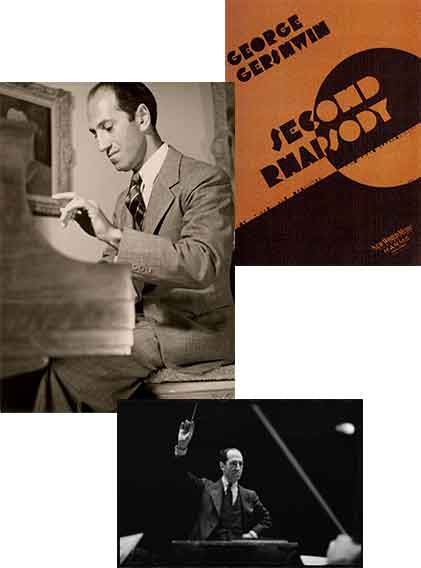George Gershwin
George Gershwin
The Jazz Age Meteor
George Gershwin, born in Brooklyn, New York on September 26, 1898, was the second son of Russian immigrants. As a boy, George was anything but studious, and it came as a wonderful surprise to his family that he had secretly been learning to play the piano. In 1914, Gershwin left high school to work as a Tin Pan Alley song plugger and within three years, “When You Want ‘Em, You Can’t Get ‘Em; When You Have ‘Em, You Don’t Want ‘Em,” was published. Though this initial effort created little interest, “Swanee” (lyrics by Irving Caesar) — turned into a smash hit by Al Jolson in 1919 — brought Gershwin his first real fame.
In 1924, when George teamed up with his older brother Ira, “the Gershwins” became the dominant Broadway songwriters, creating infectious rhythm numbers and poignant ballads, fashioning the words to fit the melodies with a “glove-like” fidelity. This extraordinary combination created a succession of musical comedies, including LADY, BE GOOD! (1924), OH, KAY! (1926), FUNNY FACE (1927), STRIKE UP THE BAND (1927 and 1930), GIRL CRAZY (1930), and OF THEE I SING (1931), the first musical comedy to win a Pulitzer Prize. Over the years, Gershwin songs have also been used in numerous films, including SHALL WE DANCE (1937), A DAMSEL IN DISTRESS (1937), and AN AMERICAN IN PARIS (1951). Later years produced the award-winning “new” stage musicals MY ONE AND ONLY (1983) and CRAZY FOR YOU (1992), which ran for four years on Broadway.

Early Days
Starting with his early days as a song composer, Gershwin had ambitions to compose serious music. Asked by Paul Whiteman to write an original work for a concert of modern music to be presented at Aeolian Hall in New York on February 12, 1924, George, who was hard at work on a musical comedy, SWEET LITTLE DEVIL, barely completed his composition in time. Commencing with the first low trill of the solo clarinet and its spine-tingling run up the scale, RHAPSODY IN BLUE caught the public’s fancy and opened a new era in American music. In 1925, conductor Walter Damrosch commissioned Gershwin to compose a piano concerto for the New York Symphony Society. Many feel that the CONCERTO IN F is Gershwin’s finest orchestral work. Others opt for his AN AMERICAN IN PARIS (1928) or his SECOND RHAPSODY for piano and orchestra, which he introduced with himself as pianist with the Boston Symphony under Serge Koussevitzsky in 1932.
In 1926 Gershwin read PORGY, DuBose Heyward’s novel of the South Carolina Gullah culture, and immediately recognized it as a perfect vehicle for a “folk opera” using blues and jazz idioms. PORGY AND BESS (co-written with Heyward and Ira) was Gershwin’s most ambitious undertaking, integrating unforgettable songs with dramatic incident. PORGY AND BESS previewed in Boston on September 30, 1935 and opened its Broadway run on October 10. The opera had major revivals in 1942, 1952, 1976, and 1983 and has toured the world. It was made into a major motion picture by Samuel Goldwyn in 1959, while Trevor Nunn’s landmark Glyndebourne Opera production was taped for television in 1993.

George's Career
George Gershwin was at the height of his career in 1937. His symphonic works and three PRELUDES for piano were becoming part of the standard repertoire for concerts and recitals, and his show songs had brought him increasing fame and fortune. It was in Hollywood, while working on the score of THE GOLDWYN FOLLIES, that George Gershwin died of a brain tumor; he was not quite 39 years old. Countless people throughout the world, who knew Gershwin only through his work, were stunned by the news as if they had suffered a personal loss. Some years later, the writer John O’Hara summed up their feelings: “George Gershwin died July 11, 1937, but I don’t have to believe it if I don’t want to.”
Gershwin’s works are performed today with greater frequency than they were during his brief lifetime. His songs and concert pieces continue to fill the pages of discographies and orchestra calendars. The Trustees of Columbia University recognized Gershwin’s influence — and made up for his not receiving a Pulitzer for OF THEE I SING in 1932 — when they awarded him a special posthumous Pulitzer Prize in 1998, the centennial of his birth.
